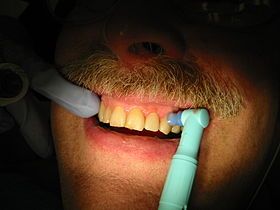Tooth polishing
| Tooth polishing | |
|---|---|
| Intervention | |

Polishing a tooth using a prophy cup.
|
|
| ICD-9-CM | 96.54 |
| MeSH | D003775 |
Tooth polishing is done to smooth the surfaces of teeth and restorations. The purpose of polishing is to remove extrinsic stains, remove dental plaque accumulation, increase aesthetics and to reduce corrosion of metallic restorations. Tooth polishing has little therapeutic value and is usually done as a cosmetic procedure after debridement and before fluoride application. Common practice is to use a prophy cup—a small motorized rubber cup—along with an abrasive polishing compound.
There is evidence of tooth polishing dating back to Roman and Greek times. However, Pierre Fauchard, the Father of Modern Dentistry, is credited for the introduction of tooth polishing to remove dental stains. Early polishing pastes consisted of finely ground coral, egg shells, ginger or salt. Within the last century, Dr. Fones, the Founder of Dental Hygiene, began educating students on coronal tooth polishing. Prior to the 1970's tooth polishing was provided to all patients as part of their complete care. As of the 1990's to 2000's evidence suggests that full mouth polishing is not always necessary. Regardless of the evidence, full mouth polishing is still widely practiced but selective polishing is being recommended as the gold standard in many educational institutions.
Prophylatic paste contains abrasives that vary in size, shape, and hardness. Based on these variants, pastes are available in fine, medium, coarse and super-coarse grits. There are also various flavours of prophylactic paste available. Some prophylactic pastes contain fluoride to aid in the remineralization of the enamel surface and others help reduce dentinal sensitivity.
Rubber cups, also called prophy cups, are used in the hand-piece. Polishing paste, prophylactic paste, usually containing fluoride, is used with the rubber cups for polishing. Rubber cups should not be used over the cementum area as it may remove a layer of cementum at the cervical area. There are two popular types of prophy cups: 4 webs and 6 webs. Risk of generating frictional heat, and increased abrasion to the tooth surface may result from increased contact time, increased speed of rotation, and increased pressure of the cup on the tooth. Short intermittent strokes should be used in order to avoid damage.
Bristle brushes are used in the prophylaxis angle with a polishing paste.The use of the brush should be confined to the crown to avoid injury to the gingiva and cementum.
Currently, the most commonly used tool for tooth polishing is prophy angle. It integrates a rubber cup into a high torque gear, which can be plugged into a low speed handpiece and drive rubber cup to polish teeth.
Dental tape is used for polishing the proximal surfaces of teeth that are inaccessible to other polishing instruments. It is also used with polishing paste. Particular care should be taken to avoid injury to the gingiva.The area should be cleaned with warm water to remove all remnants of the paste.
...
Wikipedia
